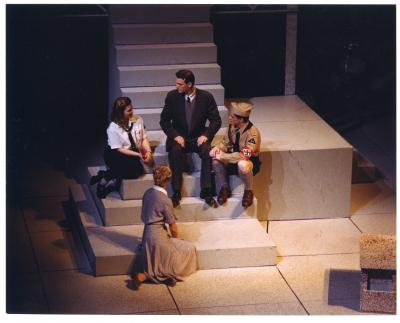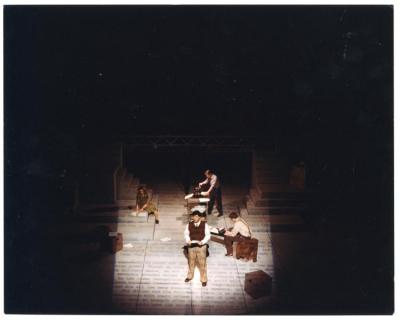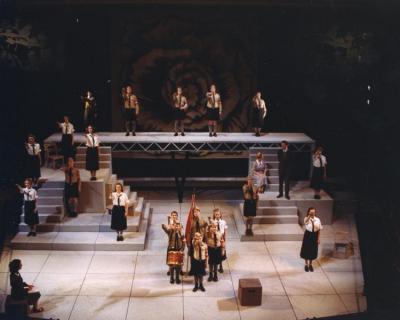Special Collection & University Archives has preserved and collected the University’s history within thousands of boxes, folders, and drawers. Many of our collections, such as the Old Gold yearbooks and student newspapers, are well known and often used by faculty, students, and other members of our community. However, there are still many collections that are relatively unknown. One collection that you might not know about is Theatre UNI Files- Programs and Photographs. This collection consists of programs, posters, and photographs from various dramatic performances through the university’s history, dating as far back as 1897 to the present as the Theatre Department donates new documents to us.
 Many of the performances included here are classics, known and loved. Still, one of a kind pieces are hidden throughout, and the Theatre Department has had the chance to perform world premieres with acclaimed playwrights. One such example is the Rose of Treason, which was performed here in 2001. I recently learned about this play while I helped a patron with a reference request. The patron turned out to be Professor Gretta Berghammer, a professor in the Theatre Department who specializes in youth theater and drama education, who played an instrumental role in this production.
Many of the performances included here are classics, known and loved. Still, one of a kind pieces are hidden throughout, and the Theatre Department has had the chance to perform world premieres with acclaimed playwrights. One such example is the Rose of Treason, which was performed here in 2001. I recently learned about this play while I helped a patron with a reference request. The patron turned out to be Professor Gretta Berghammer, a professor in the Theatre Department who specializes in youth theater and drama education, who played an instrumental role in this production.
The Rose of Treason tells the story of Sophia Scholl, her brother Hans, and their group of friends that founded the White Rose, a resistant group against the Nazi Third Reich. The White Rose was a non-violent intellectual group of like minded people that disagreed with the Nazi party or their beliefs. The group printed and distributed leaflets in secret around the University of Munich and city, criticizing and belittling the Nazi agenda. Some of their leaflets even appeared in popular German papers across the country, making them enemies of the Reich. On February 18th, 1943, Sophia Scholl brought a suitcase full of leaflets to the university so that she and other members could place them unseen around campus. However, a janitor saw Sophia throwing the last remaining leaflets from the top of an auditorium and reported her to the Gestapo. She and other members of the White Rose were taken into custody and tried for treason.
On February 22, 1943, Sophia Scholl, Hans Scholl, and Christoph Probst, were brought before Hitler’s People’s Court and faced Judge Roland Freisler, one of Adolf Hitlers’ most notorious and devoted judges. The trial started at 9 am and concluded at 1 pm that day. By 5 pm, the university students were beheaded by an executioner. Over fifty years later, the UNI Theatre Department and the Sturgis Youth Theatre performed the world premiere of The Rose of Treason.
How did this come to be? I conducted some research using primary sources in University Archives, and I also spoke with Berghammer to learn more. Berghammer was interested in collaborating with a playwright to develop a new play, created specifically with young people in mind, and premiering it at UNI. Berghammer knew playwright James DeVita through a UNI Theatre alumni connection, and she approached him with this idea. James DeVita is a resident member of the American Players Theatre acting company and is based in Wisconsin. The two met in a coffee shop, and they discussed Berghammer’s early ideas for a story depicting a young person’s experience of WWII. DeVita then presented the story of Sophia Scholl and the White Rose, which deeply resonated with Berghammer.
They set to work, and eighteen months later, The Rose of Treason was first performed with help from UNI students and children from the Sturgis Youth Theatre.
The Sturgis Youth Theatre is a program developed at UNI in 1999 by Berghammer with the goal “to provide quality productions, meaningful performance opportunities and educational opportunities to youth 4-18 in the Cedar Valley,” in her words. The world premiere was on Wednesday, April 18th, 2001 at 1:00 pm for a school matinee performance for local schools in the Cedar Valley. The production continued with showings opened to university students and the public from April 19th to the 22nd.
According to Berghammer, the play can be remembered for it’s impressive performers from the Sturgis Youth Theatre and the story of vulnerable children swept under a totalitarian state. She remembers The Rose of Treason fondly, and said the performer who played Sophia later named her own daughter Sophia.
Working with Berghammer, I learned more about World War II and the brave individuals that went against their own government to do what was right during a frightening age. I am grateful that people like Berghammer and DeVita spread Sophia and the White Rose’s story and that University Archives can help. I hope that others can be inspired by this collection and the many others within SC&UA in their own research.
Contributed by SC&UA student employee Courtney Duffy, April 2020
References
Professor Gretta Berghammer, email message to author, April 17, 2020.
Hess, Harvey. “‘Rose of Treason’ marked by inspired performances.” Waterloo-Cedar Falls Courier, (Waterloo, IA) April 24, 2001.
Lisciotto, Carmelo. “Sophia Scholl.” Holocaust Education & Archive Research Team. Holocaust Research Project, 2011. http://www.holocaustresearchproject.org/revolt/scholl.html
Rose of Treason, 2001, in the Department of Theatre Files, #14/06/01 Box 23, Rose of Treason Folder, Theatre UNI Files- Programs and Photographs, University Archives, Rod Library, University of Northern Iowa.
“World premiere play, Rose of Treason, blooms at UNI theatre,” page 10, Northern Iowan, Tuesday, April 17, 2001, Northern Iowan, Rod Library, University of Northern Iowa. https://indexuni.library.uni.edu/page-image/ni200000001162jpg


